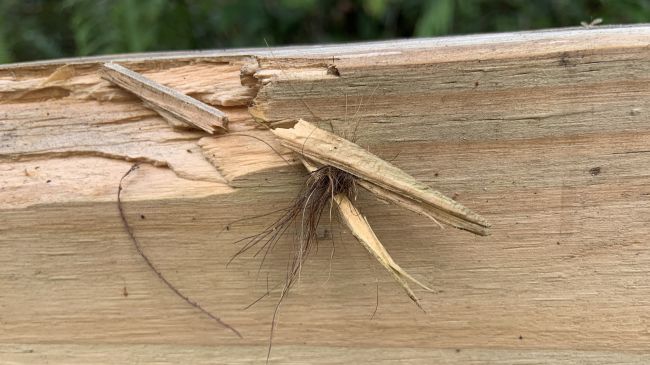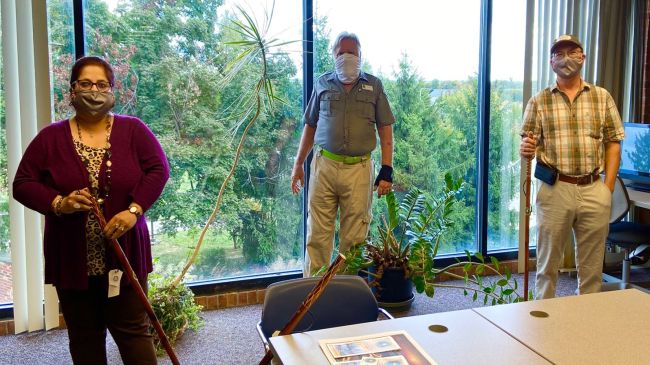By Steven Krolak
(NEW ALBANY, Ind.)–A tuft of fur. A wooden hand-rail, clawed and splintered. A request for help in identifying a mysterious predator.
Sounds like a reboot of “The Hound of the Baskervilles,” but in fact these are the pieces of a real-life puzzle solved by Kaycee Ranney, a senior from Louisville majoring in sustainability with minors in biology and geoscience.
Like so many curious tales of our time, this one began in Florida. To be more specific, it began on the Great Cypress Bend Boardwalk at Fakahatchee Strand Preserve State Park near the city of Naples.
The park, located at the northern end of the Everglades, is home to a variety of predators, including alligators, bears, bobcats, panthers and wild hogs. The boardwalk is a 2,500 foot-long raised structure that brings more than 73,000 visitors annually into the heart of the park’s swamp ecosystem, ending at a viewpoint overlooking a pond filled with alligators.
In 2019, park rangers discovered a section of hand-rail that had been deeply clawed. Amid the splinters they found a tuft of fur.

Dave Boesche, a certified Florida master naturalist and Boardwalk volunteer, realized that it was important to identify the animal responsible, to ensure the safety of park visitors and personnel. He sent the sample of fur to his son-in-law, David Taylor, professor of biology and sustainability & regeneration at IU Southeast, for an expert opinion.
Taylor was quick to seize upon the educational value of the opportunity. He passed the sample to Dr. Suparna Mukhopadhyay, lecturer of biology and curator of IU Southeast’s zoological collection, who offered it to Ranney, her undergraduate research assistant.
“Kaycee was in my Biology 102 course [Introduction to Biology] and she showed a lot of interest in my conservation project,” Mukhopadhyay said. “She wanted to do research with me on the vertebrate collection I curate, and has now been working with me on that since Spring 2019.”
As Mukhopadhyay’s assistant, Ranney catalogued and organized close to 3000 vertebrate specimens, demonstrating a diligence and an attention to detail that made her a natural fit for the project.
In the end, Ranney not only solved the riddle, she turned her preliminary results into a poster that earned her the Glenn Mason Outstanding Poster Presentation in Natural Sciences award at the IU Southeast Research Conference in May. Now she has earned a stipend from IU Southeast to complete the project.
“I love a good mystery,” Ranney said, describing her initial interest. “But I also wanted to make sure the animal that did the damage is found, since large predators are blamed and hunted if the damage involves humans.”
Ranney used a dissecting microscope to study the scales of the hair sample at varying levels of magnification. In the end, color and structural evidence strongly suggested the culprit was a black bear. This conclusion was reinforced by behavioral evidence: The horizontal rail was more likely to have been clawed by a bear than a big cat, which would have preferred a post or other vertical surface.
“Since the damage was only to the boardwalk, the animal might not be hunted right now,” Ranney said. “But this puts them closer to humans, so it’s a good idea to be ready and prepare a non-lethal means of removing them from the area.”
Boesche is pleased with the outcome, and plans to display Ranney’s poster in the visitor’s center at the park.
For Ranney and Mukhopadhyay, there are still a few loose ends to tie up. In order to confirm her findings, Ranney will use electron microscopy sequence the DNA of the hair sample, and compare the data with known DNA sequences of hair from other animal species. At this point, they can begin thinking about preparing a paper on the project for publication.

The project has been something of a reward for Ranney, who transferred to IU Southeast in 2017. While employed, she has pursued her degree and taken advantage of opportunities for travel, field study and research. Her ultimate goal is to work in marine conservation and reconstruction. To that end, she is earning a dive-master certification and organizing a trip for young divers to Key Largo, Florida, where they will visit a coral farm and learn about reef ecology.
Homepage photo: A shredded handrail and a tuft of fur at the heart of an animal mystery. Photo courtesy of Dave Boesche.


